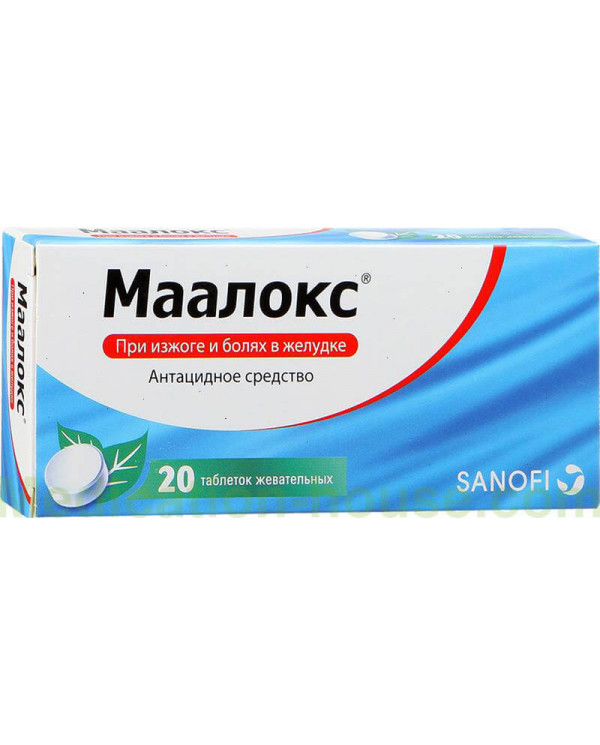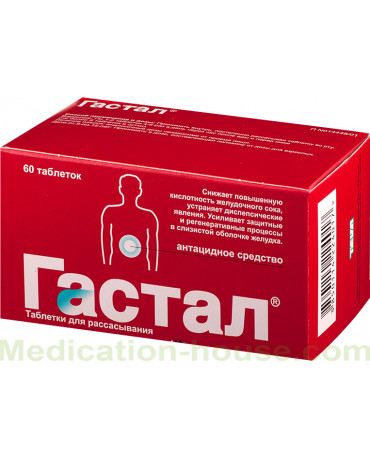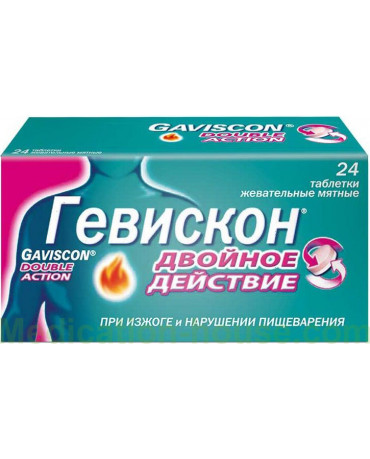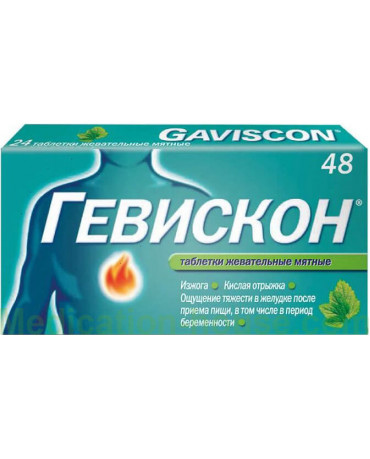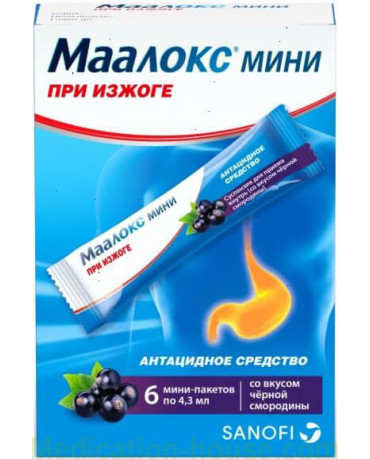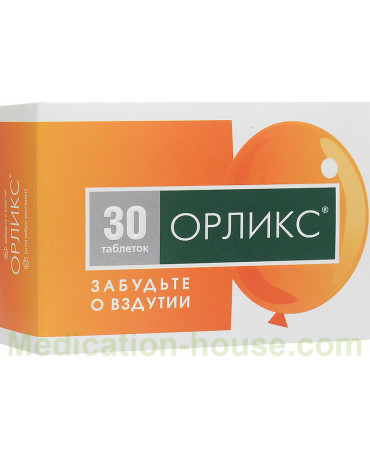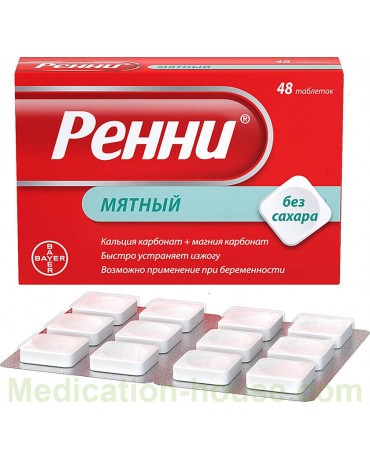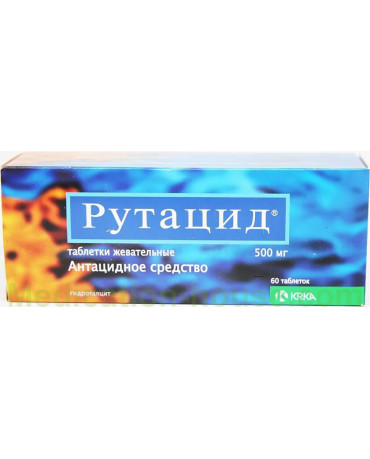Instruction for Maalox tablets
Reed more and buy Maalox tablets here
Composition
One chewable tablet contains:
active substances:
magnesium hydroxide - 400 mg;
algeldrate (in the form of hydrated aluminum oxide) - 400 mg (equivalent to 200 mg of aluminum oxide);
Excipients:
starch with sucrose (confectionery sugar) - 192 mg,
sorbitol - 125 mg,
mannitol - 10 mg
magnesium stearate - 7.2 mg,
peppermint flavoring - 3.6 mg,
sodium saccharinate - 3 mg,
sucrose - 59.2 mg.
Description
Chewable tablets: tablets of white color, round, flat-cylindrical shape with a facet and engraving "Mx".
Pharmacodynamics
Maalox tablets neutralizes free hydrochloric acid without causing secondary hypersecretion of hydrochloric acid. Due to the increase in pH when it is taken, the peptic activity of gastric juice decreases. It also has an absorbent and enveloping effect, due to which the effect of damaging factors on the mucous membrane is reduced.
Pharmacokinetics
Magnesium and aluminum hydroxides are considered topical antacids that are practically not absorbed when taken at recommended doses and, therefore, do not have systemic effects.
Indications
Peptic ulcer of the stomach and duodenum in the acute phase.
Acute gastroduodenitis, chronic gastroduodenitis with normal or increased secretory function in the acute phase.
Esophageal hernia of the diaphragm, reflux esophagitis.
Dyspeptic phenomena, such as discomfort, gastralgia, heartburn, sour belching after errors in diet, excessive consumption of ethanol, coffee, nicotine, etc.
Dyspeptic phenomena, such as discomfort or pain in the epigastrium, heartburn, sour belching (and their prevention), resulting from the use of certain drugs (non-steroidal anti-inflammatory drugs, glucocorticosteroids, etc.).
Contraindications
Severe renal failure.
Hypersensitivity to active substances and other components of Maalox tablets.
Fructose intolerance (due to the presence of sorbitol in the preparation).
Hypophosphatemia.
Children and adolescents up to 15 years.
For chewable tablets:
Glucose-galactose malabsorption syndrome, sucrose-isomaltase deficiency (due to the presence of sucrose in the preparation).
Carefully
With renal failure.
In patients with porphyria on hemodialysis.
During pregnancy (see section "Use during pregnancy and during breastfeeding").
With Alzheimer's disease.
For chewable tablets:
In diabetes mellitus (due to the presence of sucrose in the preparation).
Use during pregnancy and during breastfeeding
In animals, there is no clear indication of the teratogenic effect in aluminum hydroxide and magnesium hydroxide. To date, no specific teratogenic effects have been identified with the use of Maalox tablets during pregnancy, however, due to the lack of clinical experience, its use during pregnancy is possible only if the potential benefit of its use for the mother justifies the potential risk to the fetus.
Avoid prescribing Maalox tablets during pregnancy in large doses and for a long time.
When used according to the recommendations, the absorption of combinations of aluminum hydroxide and magnesium salts in the mother is limited, therefore, Maalox tablets is recognized as compatible with breastfeeding.
Dosage and administration
The tablets should be dissolved or chewed thoroughly.
Adults and adolescents over 15 years: 1-2 tablets 3-4 times a day 1-2 hours after meals and at night. With reflux esophagitis, Maalox tablets is taken shortly after a meal. The maximum number of doses of the drug is 6 times a day. Do not take more than 12 tablets per day. The course of treatment should not exceed 2-3 months. With occasional use (for example, with discomfort after errors in the diet) - take 1-2 tablets once.
Side effect
Subject to the recommended dosage regimen, side effects are negligible.
The following World Health Organization classification is used to indicate the incidence of unwanted side effects:
infrequent ≥ 0.1% and <1%;
unknown frequency (according to the available data, it is not possible to estimate the frequency).
Immune system disorders:
Unknown frequency: hypersensitivity reactions such as pruritus, urticaria, angioedema and anaphylactic reactions.
Gastrointestinal disorders:
Infrequent: diarrhea, constipation.
Metabolic and nutritional disorders:
Unknown frequency: hypermagnesemia, hyperaluminemia, hypophosphatemia (with prolonged treatment or taking high doses, or when taking standard doses with a low phosphate content in food), which can lead to increased bone resorption, hypercalciuria, osteomalacia.
Overdose
Symptoms
Symptoms of acute overdose with a combination of aluminum hydroxide and magnesium salts include diarrhea, abdominal pain, and vomiting.
In patients at risk, taking high doses of Maalox tablets can cause or aggravate intestinal obstruction or intestinal obstruction (see section “With caution”).
Treatment
Aluminum and magnesium are excreted in the urine. Treatment of acute overdose is carried out by replenishing fluid loss and forced diuresis. Patients with renal failure require hemodialysis or peritoneal dialysis.
Interaction with other drugs
With quinidine
With simultaneous use with quinidine, an increase in serum concentrations of quinidine and the development of an overdose of quinidine are possible.
Since blockers of H2-histamine receptors, propranolol, atenolol, cefdinir, cefpodoxime, metoprolol, chloroquine, prostacyclin diflunisalom, digoxin, bisphosphonates, ethambutol, isoniazid, fluoroquinolones, sodium fluoride, glucocorticosteroids (described for prednisolone and dexamethasone), indomethacin, ketoconazole, lincosamides , phenothiazine antipsychotics, penicillamine, rosuvastatin, iron salts, levothyroxine.
With simultaneous administration with Maalox tablets, the absorption of the above drugs in the gastrointestinal tract is reduced. In the case of a 2-hour interval between taking these drugs and the Maalox tablets and a 4-hour interval between taking fluoroquinolones and the Maalox tablets, in most cases this undesirable interaction can be avoided.
With polystyrenesulfonate (kayexalate)
When using Maalox tablets with polystyrenesulfonate (kayexalate) in combination, caution should be exercised because of the possible risk of a decrease in the potassium resin binding efficiency and the development of metabolic alkalosis in patients with renal failure (for aluminum hydroxide and magnesium hydroxide) and intestinal obstruction (for aluminum hydroxide).
With citrates
With a combination of aluminum hydroxide with citrates, an increase in plasma concentrations of aluminum is possible, especially in patients with renal failure.
Special instructions
Aluminum hydroxide can cause constipation, an overdose of magnesium salts can lead to a weakening of intestinal motility; in high-risk patients (patients with kidney failure, the elderly), taking high doses of Maalox tablets can cause or aggravate bowel obstruction and intestinal obstruction.
Aluminum hydroxide is poorly absorbed in the gastrointestinal tract, therefore, in patients with normal renal function, systemic effects are rare. However, prolonged treatment, the use of excessively high doses of the drug, or the use of normal doses of the drug against the background of low intake of phosphates from food can lead to phosphate deficiency (due to the binding of aluminum to phosphate), which is accompanied by increased bone resorption and hypercalciuria with a risk of osteomalacia . Treatment of patients at risk of developing phosphate deficiency or prolonged use of the drug should be carried out under medical supervision.
In renal failure, an increase in plasma concentrations of magnesium and aluminum is possible. In these patients, prolonged use of the drug in high doses may develop encephalopathy, dementia, microcytic anemia, or aggravation of osteomalacia caused by dialysis.
Terms of sell
You don't need a prescription to buy Maalox tablets.

